Canoe vs Kayak has been an age-old debate, and there are enough enthusiasts on both sides around the world. If you are a newbie deciding to figure out which one you should go for, it might feel overwhelming to make up your mind. That is where I got you covered.
In this canoe vs kayak guide, you will leave knowing almost everything you have to know, which will save your time whether you are just planning a Kayak or a Canoe trip or you are seriously planning to invest in these.
While a canoe and Kayak might seem similar, surprisingly not many are aware of the many differences which decide what should be used where.
In this post, you will know the differences between Canoeing and Kayaking, the many types of Kayak and Canoe, and finally which one should you choose.
Canoe vs Kayak
CONTENTS
If you are just planning for a trip to any waterfront or planning to dive full-on, these might be the probable questions that you have – Which one should I choose – Canoe or Kayak? Kayak vs Canoe – Which one is easier? What is best for me?
Let’s jump in right away to find out all the answers you are looking for.
What is a Canoe & What is a Kayak?
Before diving into canoeing vs kayaking, let’s start with the basics.
There is a lot of confusion in the terms used for Kayaks and Canoes around the world. If you are a novice, you might have used the terms interchangeably.
Demography wise, Americans call a watercraft with an open deck with slightly raised seating as a Canoe. And Kayaks are those with a closed deck with a seat next to the bottom of the hull.
In Canada and Britain, a Canadian Canoe is a Canoe, as well as a Kayak, is also known as Canoe! In Asia and SE Asia, Kayaks are open paddle craft with lower seating, and Canoes are bigger boats with elevated seating.
Canoe Vs Kayak – History
You might like to know a bit about how Canoe and Kayak had their origins and how they have evolved.
History Of Kayaks
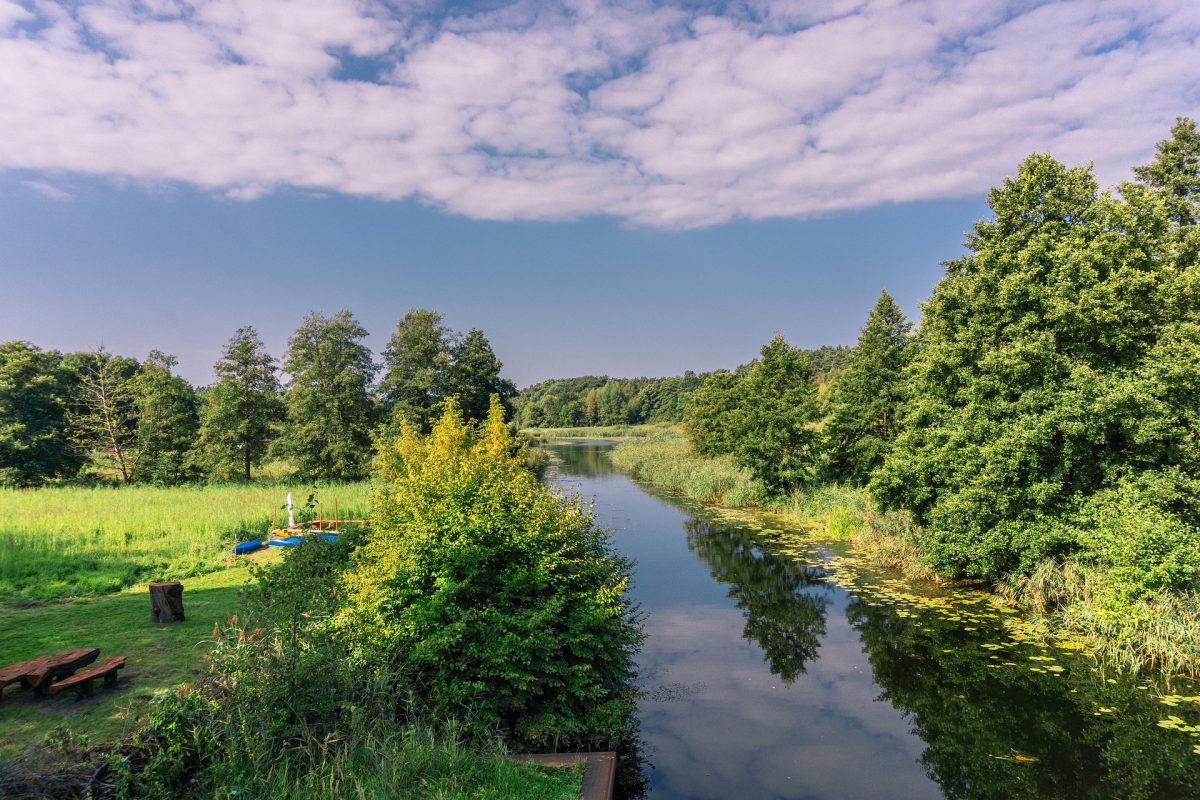
Kayaks date back to over 4000 years ago, and their history can be traced to Greenland when the Native people Inuit first built them in the Arctic as hunting equipment.
The Kayaks initially were made of light driftwood with whalebone forming the frame and covered by animal skins. The Inuit also added whale fat and seal bladders to make the vessels waterproof and improve buoyancy.
Kayak was primarily used for hunting and then began constructing bigger ones for the transport of goods and commuting.
The enclosed design protected the Inuits from the cold weather, along with providing a dry place to store gatherings. The Kayaks were designed with great difficulty to be able to be smooth for navigating through the icy waters.
In the mid-1800s, Kayak was introduced to mainland Europe, with which the use of Kayak transitioned from hunting to recreational purposes.
Kayaking became very popular in Germany and France, even getting introduced to the Olympics.
Now, Kayaking is one of the most popular forms of paddling in the world, especially in the USA, where over 15 million go on kayaking expeditions each year.
History of Canoes
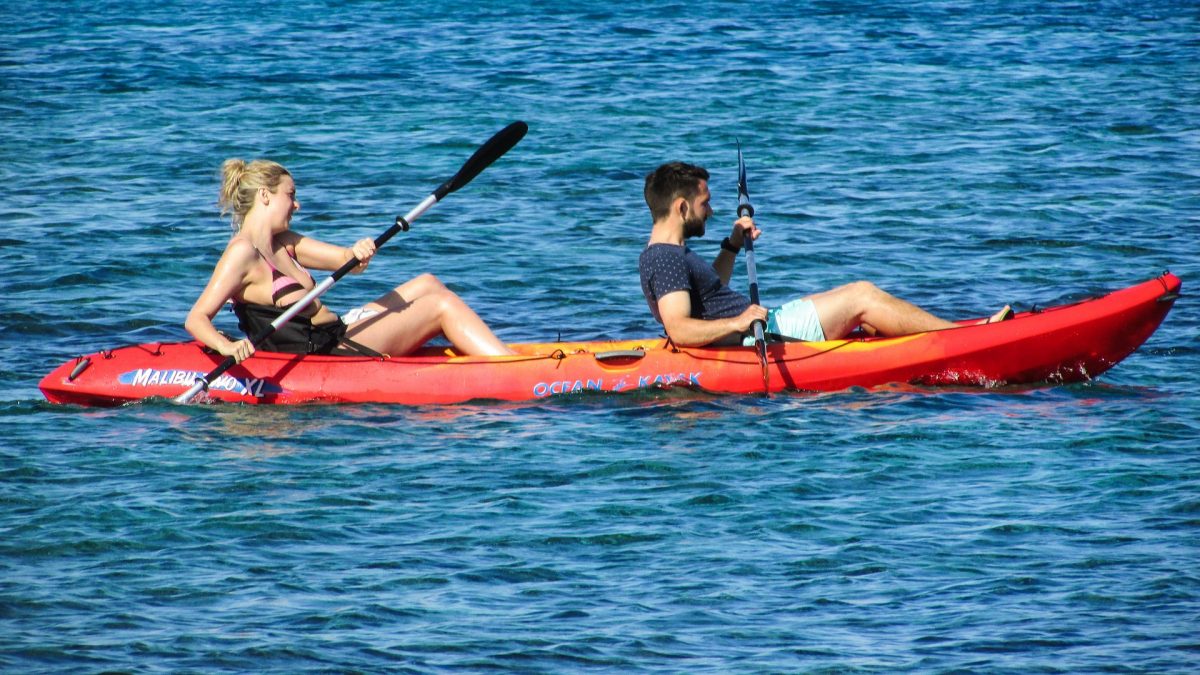
Canoes have been estimated to be even older(9000+ years) than the Kayaks with the first evidence of a wooden Canoe that was discovered in the Netherlands.
The exciting thing is remains of Canoe were also discovered in other two continents – in Nigeria in Africa and China – both at least over 8000 years old indicating that the Canoes have been known to humankind for a long time.
The logs or the trunks of the huge trees were carved out to make hollow canoes with additional wooden frames, barks and resins for resistance and buoyancy. Like Kayaks, the Canoes were initially used for transporting goods and people.
In the 19th century, Canoe evolved to become of the recreational activities, especially for families. Now Canoeing is a popular activity among family travel as well as people taking picnics to the rivers and the lakes.
Canoe vs Kayak – Types and their features
Continuing to understand more things to pursue Canoe vs Kayak, let’s get to know about the types of Kayaks and Canoes available.
Unless you pay close attention, you can easily miss the different types of Canoe as they all look pretty much the same, well, almost. The main types of canoes are:
Types of Canoes
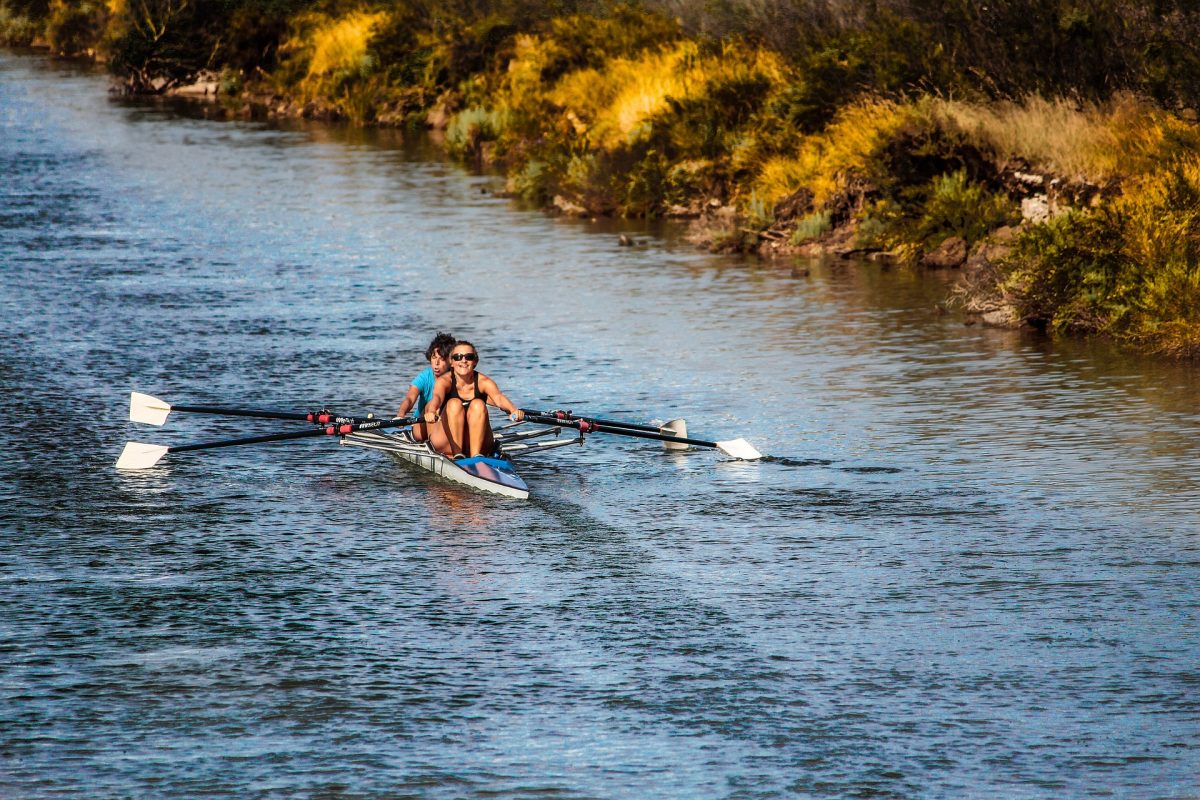
Recreational Canoe
Recreational Canoes are the most common types of Canoe that you would have seen, especially on lakes or slow rivers. They are fun and easy to paddle, and is the type of Canoe you will find at tourist rentals, most of the stores and camps.
Measuring between 13ft and 17ft long and made of either plastic or rarely aluminium, the main reasons why they are popular is because they are easy to manoeuvre, stable and steady, which makes it easy for anyone without prior experience which is useful in tourist attractions.
Also, you can have multiple seats – perfect for a family outing for fishing, photography, or just enjoying lakes, ponds and soft-flowing rivers.
Whitewater Canoes
Shorter than recreational canoes, whitewater canoes are something you should choose if you are going to canoe in fast-moving waters as the name suggests.
Although most preferred choice for whitewater paddling is Kayaks, this canoe paddle is designed for whitewater as they consist of flotation panels at the front and back of the boats that regulates excess water flow.
Built for one or two people, they are highly manoeuvrable and less stable, which means they aren’t suitable for slow waters.
Expedition Canoes
If you want an upgrade to the recreational canoes, the next ones up in the line are expedition canoes. They look very similar to recreational canoes, but on a closer look, you will notice that expedition canoes are larger with better manoeuvrability.
Slightly longer than recreational canoes by a few inches, expedition canoes are for group paddling for longer distances on rivers or large lakes. The best way to maximize the efficiency of these canoes is to use them with gears.
Racing canoes
As the name indicates a racing canoe is designed for speed, agility and stability. It means they are much narrower(for better speed) with lowered seats (for better stability) than both recreational and whitewater canoes.
They are usually designed specifically for solo or duo racing with no bench seats. So paddlers in racing canoes partially kneel to come in half-sitting position for optimizing speed and power.
Square Stern Canoes
A rare type of Canoe recently introduced, Square stern canoes are ideal if you want to go on extended canoe trips which are enabled by installing a motor. The provision is allowed by building a flat rear.
Type of Kayaks
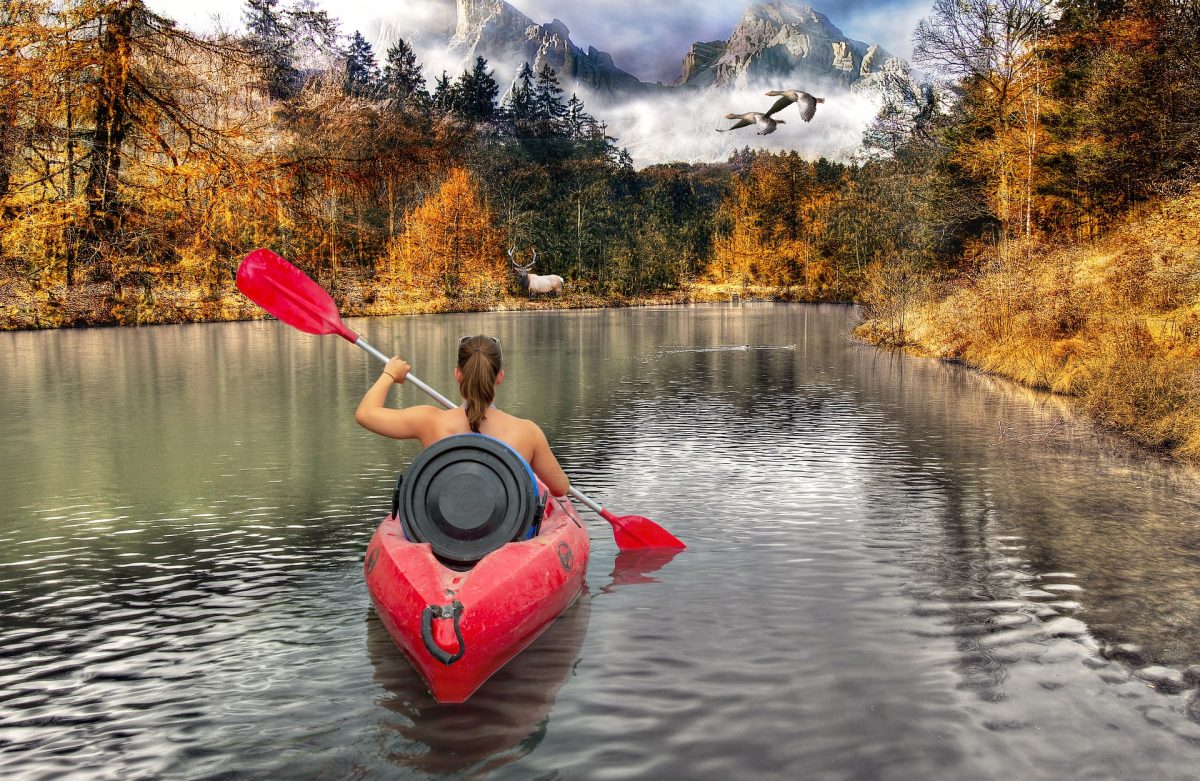
Unlike Canoes where there are limited types, you will feel initially overwhelmed by the different types of Kayaks in the store. Although it is common to feel this way, you don’t have to as I have classified to make it easier.
Once you begin to identify some specifications built for specific purposes, you will turn into a pro! Plus, to make your pick between Canoe vs Kayak, you got to know enough about both of them, right?
Design – Basically, Design-wise, all the Kayaks come under one of the three categories – Sit-inside kayaks, Sit-on-top kayaks and Inflatable kayaks.
Purpose – Further, Kayaks are classified into many types based on their purposes.
Let’s look at all types of kayaks. Shall we?
Sit-Inside Kayaks
In this type of Kayak, you will paddle less as you don’t move from side to side, but instead, use your hands alternatively to move the Kayak motor blades. Your legs and lower body are within the body of the Kayak away from the water.
Sit inside kayaks are often used for sea kayaking, Canoe Polo which is played with a Kayak although the name suggests Canoe. Sit inside Kayaks are also for whitewater Kayaking with the body being much narrow though. These type of Kayaks are usually used in cold icy waters as they offer protection via the cockpit.
Sit-on-top Kayaks
As the name indicates, there is no closed cockpit but a moulded top. These are the commonly available Kayaks that you will find in all tourist rentals as they are the easiest to use and don’t need any experience making it perfect for families and beginners.
Sit on top Kayaks are usually used in warmer regions as the paddler’s body is out and exposed without a cockpit, which means if you feel like cooling off, you can just jump off the Kayak for a swim!
One of the advantages is that the Kayak paddle can move around freely, which makes it favourable for fishing. You can also stand without toppling, and since these type of Kayaks are slightly bigger, you can also stand up. They are suitable for calm, slow waters and bigger size means they are not ideal for longer trips.
Inflatable kayaks
If you want to go on trips and do Kayaking without having to rent or carry a big Kayak around, Inflatable Kayaks are ideal. They can fit two people at a time, and as the name suggests, you can move them around.
Inflatable Kayaks are similar to Sit-on-top Kayaks in design and are perfect for short trips on calm, slow waters. If you are planning a short getaway with family to lakes or flat waters, you can combine Kayaking with these.
Note that they are less durable than the others, partially because of the relatively soft material and all the moving around.
Now let’s look at the various Kayak types falling in one of the above categories.
Recreational Kayaks
The most commonly available and accessible of all the Kayaks, the Recreational Kayaks can be both sit-on-top and inflatable. Rarely these are sit-inside.
They are around 9 to 11 feet, secure and comfortable to use – perfect for beginners and families to enjoy in flat, calm waters like slow-moving rivers, lakes and backwaters. Relatively wider, they offer good manoeuvring and stability for short paddles.
Sea Kayaks
Sea kayaks are longer and slimmer versions of recreational kayaks, like an upgrade designed or seas. The edges or the strong bows and lines are ideal to hold on to against the waves and sea winds. There are also rudders for natural movement by foot pedals. Despite its small size, there is enough storage space for all your gears including watertight hatches in the front and the rear.
Because of the excellent buoyancy, you can remain floating despite the Kayak getting filled with water which is highly possible in beaches and seas.
Day Touring Kayaks
Touring Kayaks are also much more extended and sleeker than recreational Kayaks designed for better speed and covering longer distances. Like Sea Kayaks, they also have rudders for steering with foot pedals and even storage areas at the front and the back.
Plus, they have mechanisms to enable them traveling in a straight line which increases speed. They are often available in both sit-inside and sit-on-top designs. Touring Kayaks are usually for people with prior experience and those into sports who cover long distances on flat waters.
Surf Kayaks
Surf Kayaks and Sea Kayaks may sound like built for the same – ocean and sea waves, but they are entirely different! Surf Kayaks, as the name indicates, are exclusively designed for surfing sea and ocean waves.
They come with four fins and fin three thrusters, have flat bottoms and hard rails like in surfboards. So you might get an idea that these are not suitable for calm waters or lakes. If you have surfing experience, you will enjoy Surf Kayaks on your ocean trips!
Expedition Kayaks
If you are looking for some longer trips involving water activities, you can go for Expedition Kayaks. They are usually sit-inside types, designed for lengthier excursions – broader and more prolonged than touring Kayaks.
They have excellent storage space for all camping gear, food and drinking water – all features perfect for more extended camping cum Kayaking expeditions.
Racing Kayaks
As the name suggests, these Kayaks are designed for racing coming in sit-on-top designs. As you can expect these are longer, lighter and narrower than all the other types with a higher rocker.
As such they are faster than touring and expedition Kayaks, but less stable, which means paddlers must be experienced enough to keep them in a straight line through a rudder.
Depending on their length, which can be between 15 to 35 feet long, Racing Kayaks are for sprints or marathons and can accommodate up to four people per boat, ideal for group paddling on flat water.
Fishing Kayaks & Scuba Diving Kayaks
These Kayaks are the latest to join the types of Kayaks. Both Fishing and Scuba Diving Kayaks ideally come under Sports Kayaks, which means Kayaks designed for specific sports. Fishing and Diving are the most popular activities people enjoy combining with Kayaking, because why not? Double fun!
While fishing kayak is sit-on-top Kayaks slightly closer in design and size to recreational Kayaks, Diving Kayaks are sit-on-top similar to Surf – narrower and faster and suitable for beaches.
Whitewater Kayaks
The reason I have kept these Kayaks at last in your quest for Canoe vs Kayak debate is that Whitewater Kayaks themselves are further grouped(I know, hang on!)
It is essential to choose the right whitewater Kayak based on your experience and the activity. In general, these are slightly wider but shorter than recreational kayaks, come in sit-inside design.
But they are shorter in length, and because of their hulls having a much higher degree of rocker, they are exceptionally well manoeuvrable, responsive and buoyant when tossed around in whitewater.

Let’s quickly look at all the types of Whitewater Kayaks.
Inflatable Whitewater Kayaks
Inflatable might seem unsuitable for whitewater, but surprisingly, they are highly preferred, especially if you are a beginner learning to manoeuvre through the rapids. It is possible due to their stable design, comfort and lightweight.
It might be less comfortable to navigate than a few of the below ones, but if you are a novice with having never tried this before, Inflatables are the best bets.
Creek Boats
Creek boats are designed for intermediates, for those trying to upgrade themselves in whitewater Kayaking. They are shorter than most other types. They are designed explicitly for daring to venture further navigating through whitewater.
They don’t submerge quickly, and even if you do, they will resurface thanks to the excellent design. Perfect to master Kayaks in whitewater.
Play Boats
If you have mastered whitewater Kayaking with Creeks, you should next try your hand at Play Boats, which as the name suggests, are for play and fun! Designed for riding whitewater waves, they are your beasts to tame if you know how to make your way through whitewater like a boss!
River Runners
River Runners are for the experts, at the top in the line of Kayaks – for adventurous souls adept at whitewater up and down streams.
Canoe vs Kayak – Pros Cons
Now that you know the different types of Canoes and Kayaks, to get one step closer to resolving Canoe vs Kayak dilemma, take a look out the pros and cons of both Kayaks and Canoes.
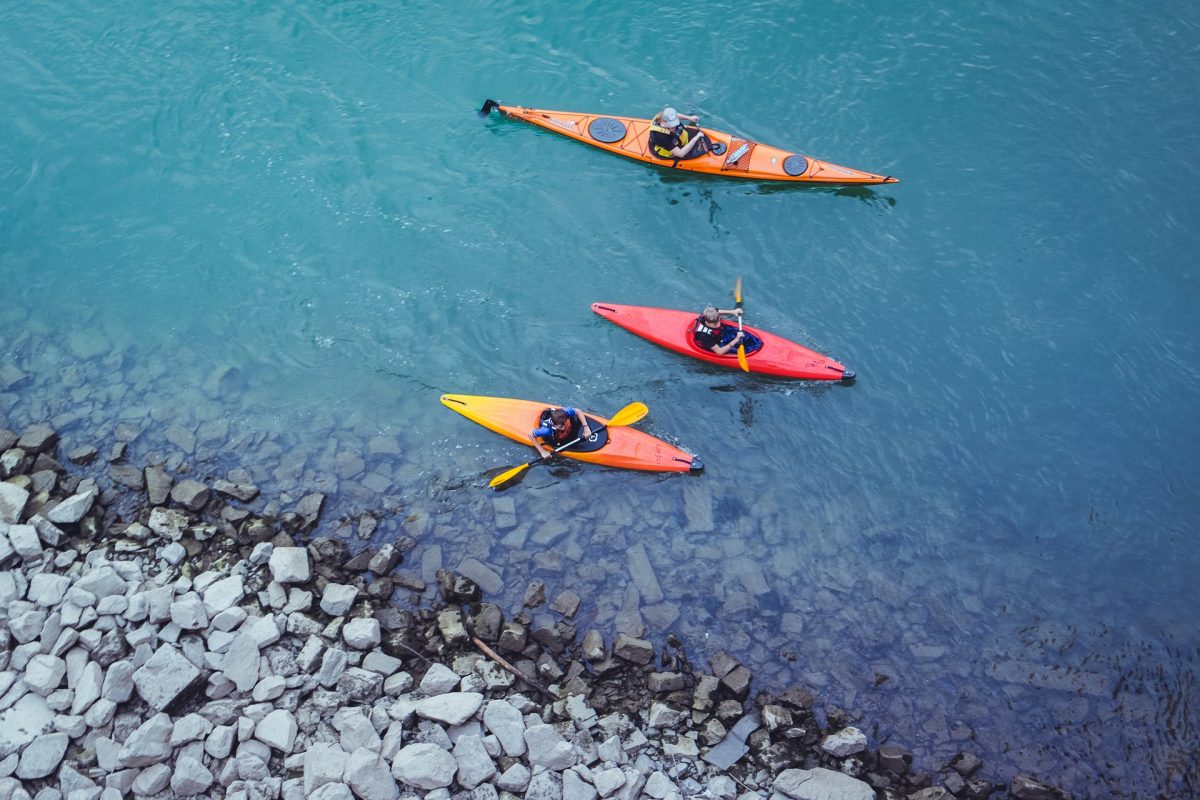
The Pros of Canoeing
Here are the pros of Canoes:
- Spacious storage space – Compared to Kayaks, Canoes have a better storage area to carry gears and any equipment comfortably.
- Better for longer expeditions – Because of their comfortable on the top seating, broader width and sufficient storage area, Canoes are excellent for longer excursions with families and friends.
- Stability – Canoes are stable, wider, with better hull and beam and hence cannot easily capsize like the Kayaks.
- Better seating & easy movement – Canoes have comfortable seating, usually for more than one, which is why it is popular among families. It is easy to move around, switch places and flex your legs, all of which are not possible in Kayaks.
- It may see simple trivial, but it is easier to get in and out of Canoe. You can also stand up easily, and if you have tried both, you will notice that all these movements are easier on Canoes.
- Can’t get wet – You can’t get possibly get wet easily on Canoes, the only exception being whitewater. Also, because of their elevated searing, the views are more enjoyable from Canoes.
- Pets can enjoy Canoes – You can bring your cats and dogs on Canoe easily as there is enough space for them.
- Easier for portage situations – Because you can easily carry gears, portaging, by-passing sections of water by getting overland, is easier with Canoe.
The Cons of Canoeing
There are a few Canoes cons that can’t be overlooked while deciding Kayaks vs Canoes.
- Difficult to transport – Since Canoes weigh more and are bigger than most of the Kayaks, transporting them is difficult.
- Difficult to manoeuvre & track – Canoes are tough to navigate primarily because they are heavy and need more efforts. It is also tough to maintain a straight line or a track on a Canoe.
- More Paddle Efforts – It is easier to paddle Kayaks than to Paddle Canoe. because the hull design is less efficient and Canoes have single paddles.
- Less Speed – Because of extra efforts to paddle, the Canoes are slower in speed compared to Kayaks meaning you need to paddle extra hard to move Canoe at its top speed vs Kayak at its top speed.
- Tough for Solo Paddlers/Beginners – Kayaking is relatively easy for solo travelers, while Canoeing is difficult if not impossible, especially if you have very less experience in any form of paddling.
- Will sink if capsized – Although Canoes are difficult to be capsized, in any event of capsizing, Canoes sink, unlike the Kayaks that will resurface.
- Not suitable for whitewater – Not that no one Canoes on whitewater, but you must have noticed that Kayaks always are the first preferences when talking about Whitewater. This is because Canoes take in more water than Kayaks, making them additionally challenging to manoeuvre. It is easier to tackle the rapids on a Kayak at a high speed than a Canoe that struggles.
- Not ideal for hot weathers – If you don’t like it too sunny, you may not enjoy being on top of Canoes with open cockpits, being exposed to sun, and in rough weathers to wind or water sprays.
- No waterproof area – Only a few of the Canoes have watertight storage areas, and those that have are expensive.
Kayaking Pros

Ideally, most Canoes Cons are Kayak Pros. Let’s look further.
- Learning Kayaks is easy – Anyone can Kayak. Anyone can Canoe too, but if you have never tried either, you will get hands-on Kayak basics sooner than Canoes.
- Faster & Easier to Paddle – Kayaks are easier to paddle, requires less effort, and as such you can navigate with better speed.
- Easy to track, stable & navigate – Most Kayaks come with two paddles, which makes easier to maintain a straight line and steer. Kayaks are also more stable on water waves and also all open waters.
- Lighter & easier to transport – Since most Kayaks are light-weight, you can easily wrap them to the back of your cars and transport wherever you want. Plus, you have inflatable and foldable versions which are a plus for Kayaks.
- Versatility – There are many varieties of Kayaks for different purposes and also many levels of learning in Kayaking than in Canoeing making them more versatile.
- Waterproof storage area – This can be a determining factor in Kayak vs Canoe. Unlike Canoes, there is a dry storage area in Sit-inside Kayaks
- which is waterproof. Although smaller than Canoes, watertight storage is essential especially if you are in the rapids of whitewater.
- Better suited for whitewater – As already mentioned above, Kayaks are preferred for whitewater because of design reasons.
- Great for fitness – Kayaks are one of the most adrenaline-inducing workouts you can ever try. Who said Kayaking should only mean fun!
- Can be more connected – Since you will be more closer to the water, you will enjoy the connection of involving in-water activity.
- Closed Cockpits – Sit-inside kayaks have closed cockpits, which will protect you from sun, wind, and spray if any of these feel overwhelming to you.
- Better to handle capsize – In the event of a capsize, Sit-inside Kayaks can be rolled upright, called the Eskimo roll or Kayak roll.
Kayaking Cons
- Advanced Kayaking is tough – Although it is pretty easy to get the basics of Kayaking right, you will need to more time and effort to learn advanced skills.
- Less load capacity – Unlike Canoes, you cannot carry large gears or luggage on a Kayak due to the limited place.
- Prone to capsize – Canoes are much difficult to be capsized, but Kayaks can easily topple as they are lighter, faster and more used on whitewater rapids.
- Paddling might be difficult for beginners – If you are just starting, you will find the double paddling to be daunting initially.
- Whitewater Kayaks can be scary – If you are new to Kayaks or whitewater, it can be scary to transition as you navigate from flat water to high volume rapids.
- Difficult to move around – Kayaks are more difficult to enter and exit. Also, closed cockpits mean less frequent movements.
- Chances of getting drenched are high – Because you are in close proximity to the waters all the time, don’t expect to come out of Kayaking totally dry!
Canoe vs Kayak – The Differences
If you are wondering what’s the difference between canoeing and kayaking, well there are many differences between Canoes and Kayaks. For you to easily understand, I have categorised based on some parameters.
Selecting Canoe vs Kayak sides also depends on many factors that come into play, based on which you can make your pick. And yes, these are subjective so two people may not pick the same side.
Let’s dig deep into Canoe vs Kayak stability, Canoe vs Kayak design, Canoe vs Kayak speed, Canoe vs Kayak with dog and more.
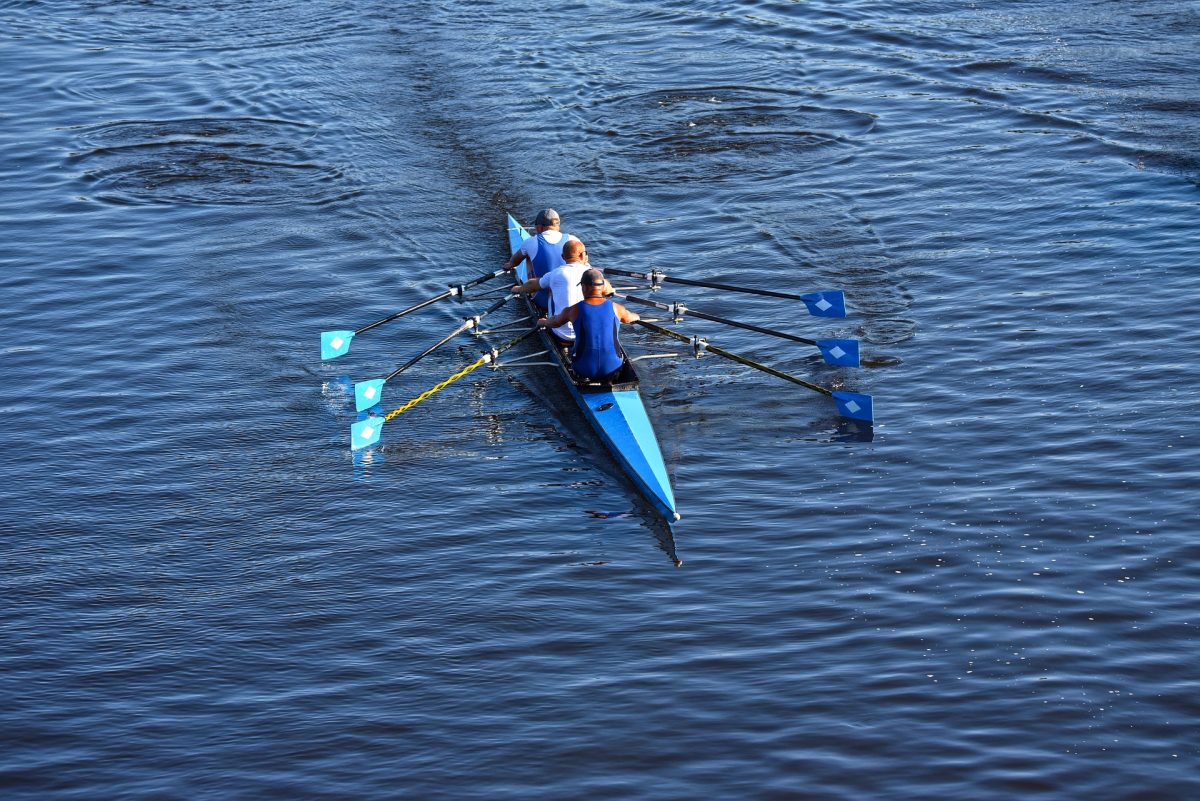
Size
Canoes are larger than Kayaks. Canoes measure between 13 to 18 feet on an average, while Kayaks measure between 6 to 15 feet.
Cockpit Design
Most of the Canoes you come across are tall Canadian style canoes with a wide hull, open cockpits, meaning seating at a much higher level than those found in Kayaks – Canoe boats are totally open – like a rowing boat.
Kayaks are known as closed with a cockpit for the paddler to sit in. More closer to the water, a paddler has to kneel or sit while paddling.
Seating Design
Canoes are comfortable for longer trips mainly because of their seating design. Elevated seating on a bench means you can sit upright, and also be able to flex your legs or stretch, all while enjoying the views thanks to the raised height over water. If you want to increase speed and power, you can kneel. There are absolutely no chances of you getting wet too, and also can access anything from the storage.
Kayaks have cockpits that may be enclosed as if sitting inside a semi-capsule. In other Kayak types, you sit almost close to the floor, with folded legs or slightly stretched. It is highly possible for you to get wet because of the close proximity to water, which you can overcome to some extent with the help of a water skirt. But water can still easily enter Kayaks, and you will likely be sitting soaked and feeling soggy.
Entry & Exit
Since Canoes have an open-top design, it is easier to get in and out of them. You can make use of the docks on the sides to get steady and also stand up.
As for the Kayaks, getting in and getting out are both difficult tasks. You need to take care not to topple. Getting in as you have to get inside a cockpit in some cases, and once you get in, you are kind of stuck, unlike Canoes where you can move freely. This also makes exit tougher.
Comfort
If you prefer comfort and safety, you should choose Canoes, which are for having relaxing trips with families or friends. Compared to Kayaks, Canoes are better suitable for longer trips.
If you don’t care about getting wet or dirty and adventure beckons you, Kayaks are your best bets. Speed, fun and adventure are the elements of Kayaks. You can customize to get backrest on Kayaks. But the downside is you can’t go on long trips as you will be cramped with lack of space for stretching your legs.
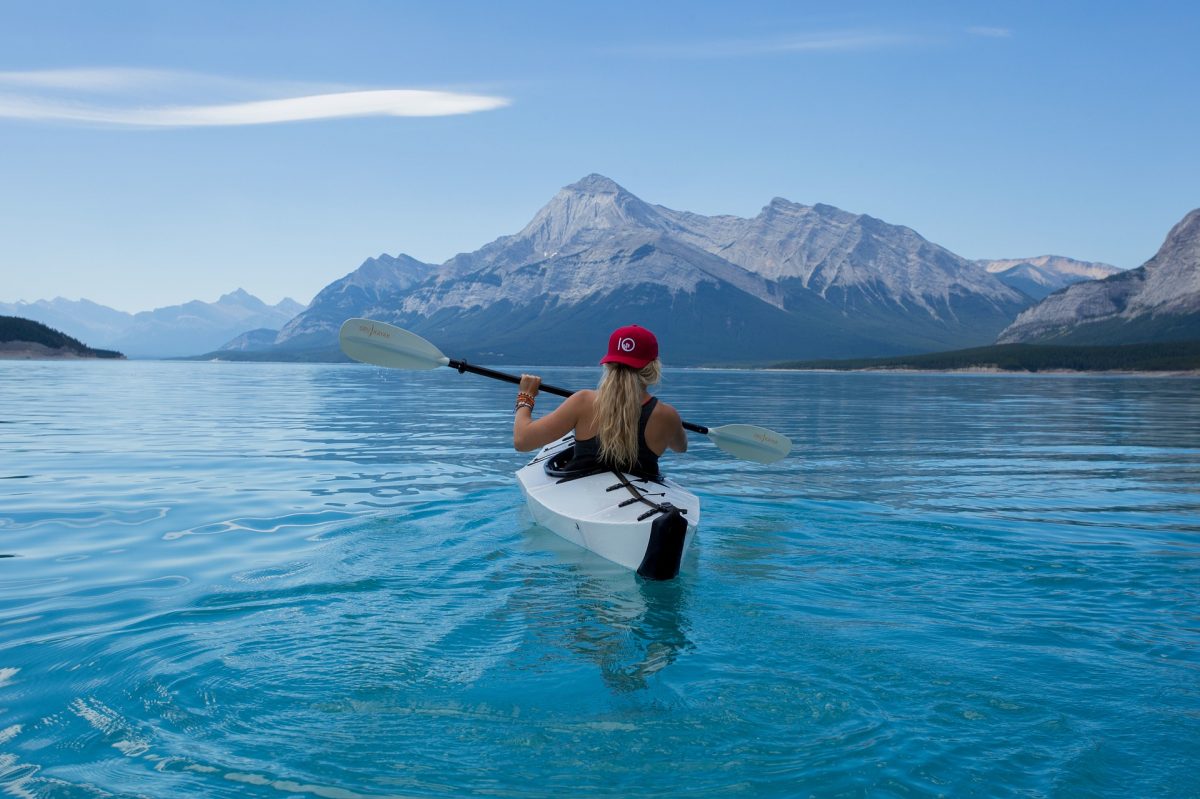
Paddles
When it comes to paddles, Kayaks have an upper hand over Canoes. Canoes usually have a single pedal with a paddler having the options of using one side or alternating the stroke. This requires extra effort, especially to keep a straight line. Especially, if you are a beginner, you will find it hard to learn to paddle on a Canoe.
Because Canoes are heavier and larger, experienced or not, you will have to put extra efforts to paddle. Having a company will ease a bit, as you can plan to do alternate strokes.
Kayak paddles have two blades, one on each end of the paddle shaft. Paddlers can use alternative sides to drive forward. Also, two paddles enable easy tracking as well as navigation.
Stability and Maneuverability
Stability – Canoes are broader with a wide hull, which gives stability when on calm waters, along with a flat bottom. Kayaks have less hull but come with rudders that help in steering forward easily. Kayaks are narrower and are built more for speed rather than comfort and stability.
Also, many modern fishing kayaks are equipped with rod holders, tackle storage and gear wells.
Manoeuvrability – Kayaking is a full-body experience, where you fully engage most of your body as you paddle, sitting close to the water surface. Plus Kayaks are lighter, and exerting your full-body power makes them extremely manoeuvrable, even in dangerous waters like whitewater, making them very popular among adventure enthusiasts.
Canoes need skill rather than power to navigate, as they are heavier and fuller. They move slowly too, and you have to work to track them. Unlike Kayaks you can’t quickly change directions easily even with two people.
Verdict – If Canoes win the prize for stability, Kayaks are known for their easier manoeuvrability.
Capsizing & Safety
If you are on whitewater, Kayaks handle the dangers better(of course, the paddlers control), and the chances of capsizing are low although highly probable. Even if they topple, you can use a few techniques to set things straight.
On the other hand, Canoes are better suited for calm waters where there are fewer chances of capsizing, plus, Canoes are more stable and the probability is very slim. However, in the event of any toppling though, Canoes can sink, and it requires some training to survive and also tot urn them back on.
Paddling Solo or with Family
One of the major deciding factors while concluding on Kayak vs Canoe is your company during paddling. Are you a solo traveler who also goes solo paddling? Do you want to paddle with your family? Are you a couple?
Canoes in the beginner’s range are often less expensive and are by default designed to accommodate at least two people. On the other hand, Kayaks are slightly expensive, and if you have more people – especially kids, you will need one or two or even more, which is not feasible if your kids are too young to paddle along with having to shell out a lot of money.
That’s where Canoes come in handy – economical and worth for trip with friends or families.
If you are wondering if it is Kayak or Canoe for family, it is Canoe.
If you are a solo paddler or a couple, go for Kayaks and Canoes are the best bets if you have kids.
Canoe vs Kayak with dogs aka Paddling with your pets
What about paddling with pets? If you want to go paddling with pets, especially dogs, I’d recommend you going for Canoes. They have spacious seating as well as some area for them to move a bit. Plus, Canoes can handle the weight well too.
Speed
By now, you must have already got the message that Kayaks have better speed than Canoes, irrespective of how many people you have on each of them.
Vehicle Loading
One of the important things that you need to consider while making a decision between Canoe vs Kayak is are you going off the beat locations for paddling? How often are you going to get off and on your vehicle?
What kind of car do you have? Canoes are bulkier and larger occupying a great deal of space, and it is also not easy to just dump them and get going. Even if you are going for shorter trips, you will at least two people to load and unload your Canoe. Of course, a smaller Canoe works better, but then they may not be feasible for families.
Kayaks, on the other hand, are easier for movement anywhere. Even if you have to walk for a few miles deep to reach the water bodies, you can simply carry them, which is impossible with Canoes! Additionally, they also have carry-in handles which make your life further easier.

Durability
When you are just starting out, durability might not be an important factor yet, but if you are going to be in it for the long haul, you may as well give it a thought. Much depends on where and how often you are going to use them.
Are you going to launch on flat lakes or beach fronts? Are you going to go to the rapids? Will you be going through any rugged terrains?
Well, you may not have answers to all of these questions right now, which makes perfect sense, but the point is you need to have an idea of what’s your plan with the paddle craft that you are going to choose, especially if you are planning to own one.
Kayaks are more durable and long-lasting than Canoes. This is where it makes it worth to pay those extra dollars for your Kayak. Kayaks were used extensively for hunting(the original purpose of its invention), and it has had all the elements – light, easy to carry around and maintain ever since its inception, making it a clear winner in this aspect.
Canoes are only good if you have people to help you carry around(even then, it is tedious), and if you take camping trips and not hopping from to one place to another.
Storing Your Gear
As mentioned earlier, Canoes have a spacious storage area, good to carry any gears or luggage you need. The availability of wide decks means you can carry equipment and essentials for going on longer excursions.
Kayaks usually have a small area for storage, usually below the deck. Except for larger Kayaks like Sea Kayaks, most don’t have the provision for storing anything essential. So in terms of volume, Canoes win for storage area.
But what should be looked into here is the waterproofing. Despite the large deck sufficient for storing things, Canoes don’t come with waterproofing. Usually, it is unusual for water to enter Canoe, but when it does happen, you don’t want your valuables to be destroyed!
Kayaks have watertight storing, although small in volume. Depending on whether you are going to utilize storage and where you are going to paddle, you can make your pick. If you are not going to store any valuable(electronics) or anything that might get wet, you can go for Canoes.
Canoe vs Kayak Fishing
What’s Better for Fishing – Canoe vs Kayak? Both Kayaks and Canoes have users for fishing.
Canoes are known for their versatile usage – you can use Canoes on lakes, rivers, flat waters, and you can enjoy Canoe fishing with families and friends too. You can just get your rod with the bait ready, grab a beer and wait for the catch. Go for Canoes fishing if you want to fish as well as socialize.
To look further to answer, which is better for fishing: a canoe or a kayak, let’s see the downsides of both as well.
As Canoes come with a single-bladed paddle, you might find it disturbing to paddle straight, especially if you are alone while fishing, making it inconvenient. You could add a trolling motor to help with this though.
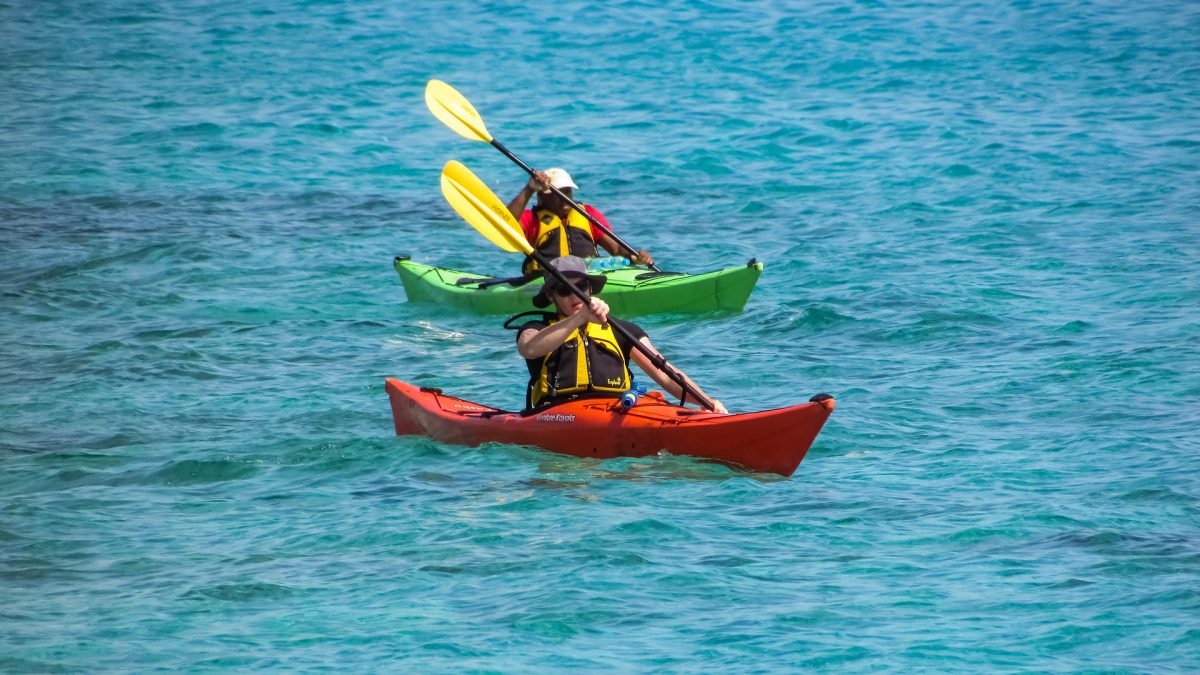
Kayaks can move easily in water with great speed for relatively little efforts. Double paddles mean you can also maintain a straight line even if you are alone. Plus there are many fishing Kayaks specifically built for this experience, in which you can also stand up as well as access dry storage. Kayaks do well in rough waters, along with rivers. If you are going for sit-inside Kayak, then you can also stay warm.
As you can see there are some things to decide fishing Kayak vs Canoe.
So is Canoe or Kayak better for fishing? It boils down to your personal preference. You can choose Canoes for family trips, for leisure socializing picnics of shorter duration on calm waters. If you want more of fishing experience in whitewater with some adventure and don’t care much about comfort, then you may go for Kayaks.
Canoe vs Kayak: Which One Should I Choose?
By now, as you can see, you know that there are many types of canoes and kayaks designed for different purposes each with their pros and cons.
So, what’s better Canoe or kayak? The answer to this question ultimately depends on you as you have to factor in a few things to make the decision.
Also, it is best if you can try both before you commit all your time and money to one or the other.
Try answering the below questions to make it easy, especially if you are new to the sport of paddling and are still undecided on which type of paddle craft to choose.
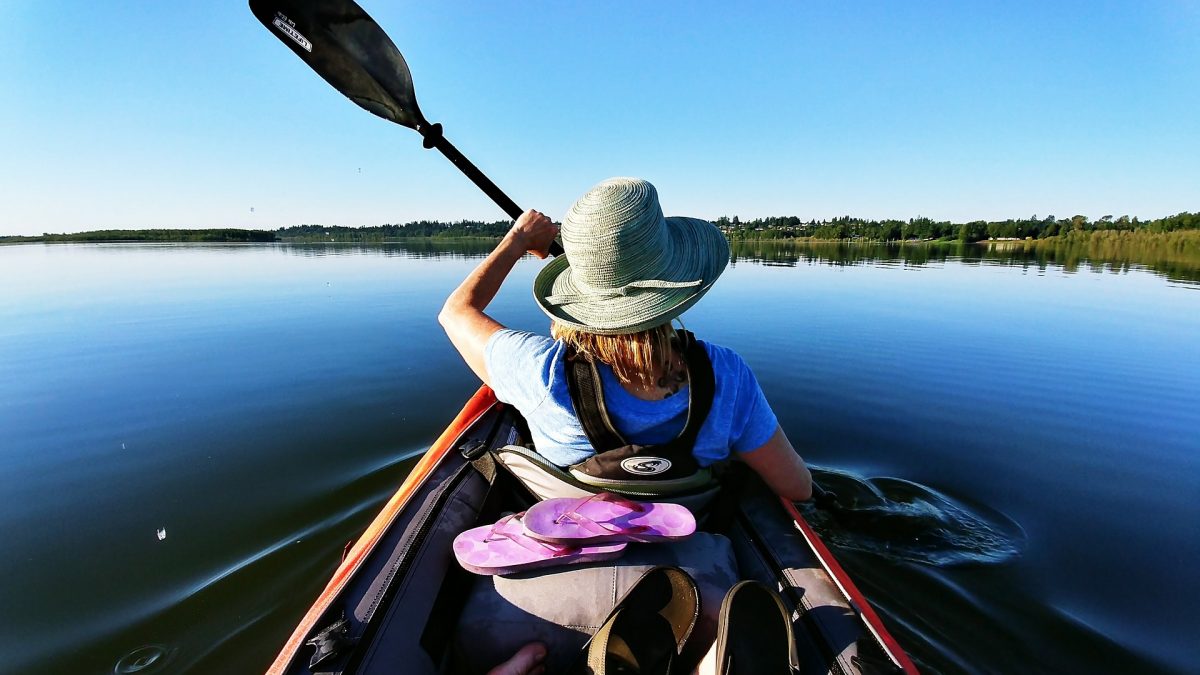
Where will you go paddling the most?
Are you going to lakes, rivers and other calm and flat waterbeds, or do you enjoy the challenges of whitewater paddling? Do you want to take it slow or get the adrenaline flowing?
What kind of paddling trips would you go on?
Do you want paddling to be on short picnics or do you want to get deep into the wilderness for camping in the woods and paddling for days?
Are you going to paddle solo or with groups?
Are you always going to go solo paddling? Or do you intend to go on with family and friends? Do you have pets that you would like to take along? You need to look at these things to make a choice between Canoe vs Kayak.
Is speed important to you or stability?
If you favour covering longer distances at faster speeds with minimal efforts, Kayaks are best. If you want to take it slow, and paddle while enjoying a beer, Canoes are for you.
If you fear to capsize, Kayaks may not be best as Canoes are the winners in this area.
Can you handle load capacity?
Are you going to carry a lot of gears on board and wouldn’t mind about the slower speed as a result? Can you handle the load capacity of fellow companions or pets? Then Canoes might be a good pick for you.
On the other hand, if storage weighs you down or speed is your thing, you may look into Kayaks.
How often will you enter and exit your paddle craft?
If you plan to have frequent stops and exit and enter often, Kayaks wouldn’t help as it gets clumsy to get on and off frequently. Also, for portage from one body of water to another, Canoe is a better choice.
Canoe vs Kayak – Final Thoughts
If you have made it until here, congrats, you learnt quite a bit about Canoe versus Kayak – Their features, types, pros and cons and what to look for.
So finally, is it Canoes or Kayaks? Ultimately, it is subjective to an individual as there is no single winner in Canoe vs Kayak. Your purpose, whether you like travelling alone or in groups, your preference for speed, stability, you experience and other factors will all be at play when you want to choose one.
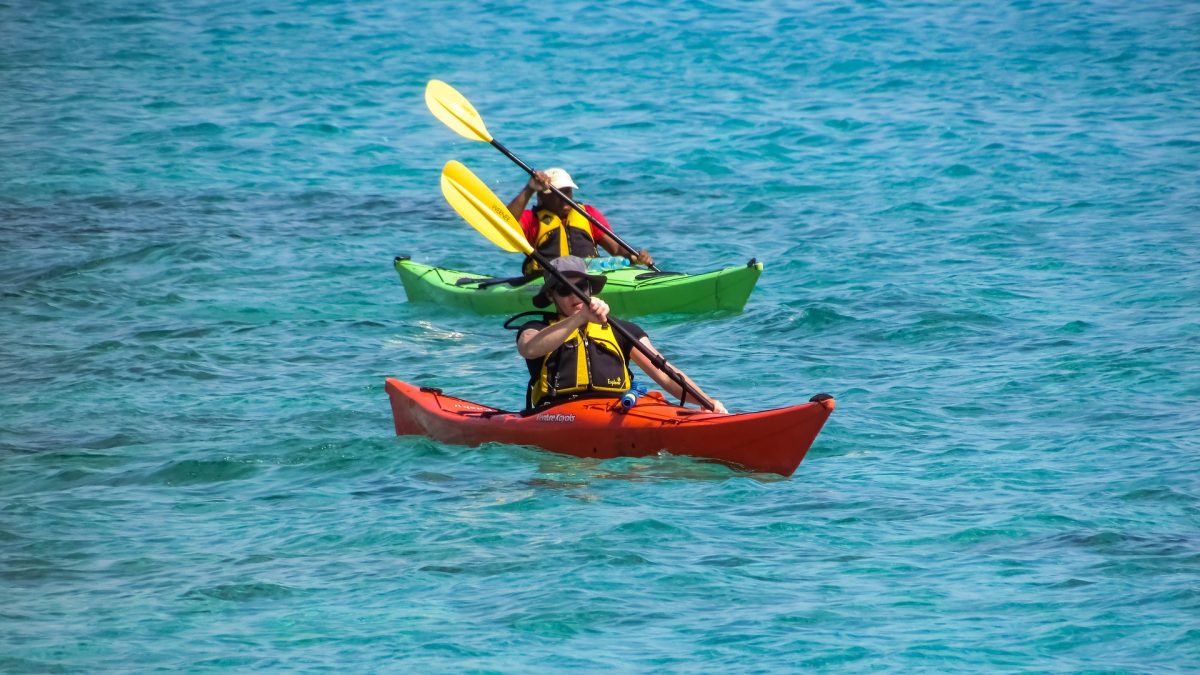
I’d highly recommend you to not overthink or be overwhelmed with these choices. Instead, rent out and try your hands at both, and see what you like and enjoy the most. Kayaks or Canoes – no matter what you pick, you will end up enjoying paddling. Go out, paddle, have a blast in the beautiful nature and make new friends.
After all, that’s what travelling is all about, right?
- Your Ultimate Guide to the Best Things To Do in Krakow, Poland - April 12, 2024
- Exploring the Hidden Gems of European Ski Resorts - March 28, 2024
- 25 Beautiful Landmarks In Poland For Your Bucket List - March 16, 2024




